Birdwatching is an activity most people don’t know a lot about. It’s not because the birds don’t interest them.
But more because they don’t know much about them and don’t take the time to learn more about them.
Some people have already mastered the skill of birding, and they love to share what they’ve learned with others.
In this list, we’ll show the top 10 smallest bird in the world, the smallest bird species on the planet.
We also list some bird species that might be among the smallest, but they are not on the list because they were not verified. The birds of the size in the list are small in size.
However, due to their nature, there is no limit of their size. A tiny bird for the size of that, will definitely fit in your hand. In reality, there is no limit to the smallest bird on planet.
There are about 10 other birds which are also smaller in size than the birds in this list. However, these are birds of different species and they are not the common birds that we see in our day to day life.
Read further to know the birds on the list.
10 out of 10
Golden Headed Cisticola (Cisticola Exiles)

Golden Headed Cisticola is average 3.9 inch, weight 8 grams.
Scientific Classification of the Golden Headed Cisticola
- Scientific Name: Cisticola Exilis
- Common Name: Golden-Headed Cisticola
- Kingdom: Animalia
- Phylum: Chordata
- Class: Aves
- Order: Passeriformes
- Family: Cisticolidae
- Genus: Cisticola
- Species: Cisticola Exilis
Golden Headed Cisticola, or Cisticola exiles, is a distinctive member of the typical ‘African warbler’ family Cisticolidae. It occurs from Liberia to northern and central Uganda.
And probably also in southern Kenya and eastern Democratic Republic of the Congo (from the Ituri River westwards) to western Tanzania (from the coast westwards).
The species was first described in 1858 by German ornithologist Gustav Hartlaub. This species has a plain brown back and buffy-white throat with black lores and undertail coverts.
It is most easily distinguished from its close relative, White-throated Cisticola, by its more rounded tail and black throat (vs. the more sloping tail and blackish throat of the former species).
It has a white rump in both sexes. The sexes can be distinguished by their bill colour: the male has a yellow-orange bill, whereas the female’s is blackish.
Habitat and Distribution:
Golden Headed Cisticola occurs in dry deciduous to semi deciduous forests, secondary growth and cultivated areas in southern India.
It occurs in and out of the driest parts of its distribution area and is fairly common in a few areas and is listed as Least Concern in the IUCN Red List. They can be found at elevations up to 1300 metres.
Behaviour and Ecology:
Golden Headed Cisticola are not commonly found in the open. Instead, they are commonly seen foraging along the ground for plant ephemerals.
Breeding:
Golden Headed Cisticola is a seasonal breeding bird, with males and females breeding at different times of the year.
Males of this species have been seen singing from mid-April to early November. The golden-headed cisticola breeds in small numbers.
Courtship includes wing flutterings by the male and duets of the female and male singing. Nest sites are within a radius of 20 m of a large tree.
The nest is a cup made of plant fibres and decorated with small twigs and leaves. The typical clutch is two eggs, one of which is usually larger than the other.
With olive-brown to dark brown, speckled, irregular spots and blotches on a tan-brown background. Eggshells are thin and leathery.
Food Habits:
Golden Headed Cisticola eats a variety of plant seeds and fruits, as well as ants and spiders. Its diet is relatively diverse and is similar to that of the yellow-billed cisticola.
Flight:
Golden Headed Cisticola are aerial insectivores that feed on the ground as well as on insect prey flying around.
They are fast fliers, and fly high above the ground with long, fast wingbeats. The tail is very long and held vertical during flight. Males use this tail as a display or call.
9 out of 10
Verdin (Auriparus Flaviceps)
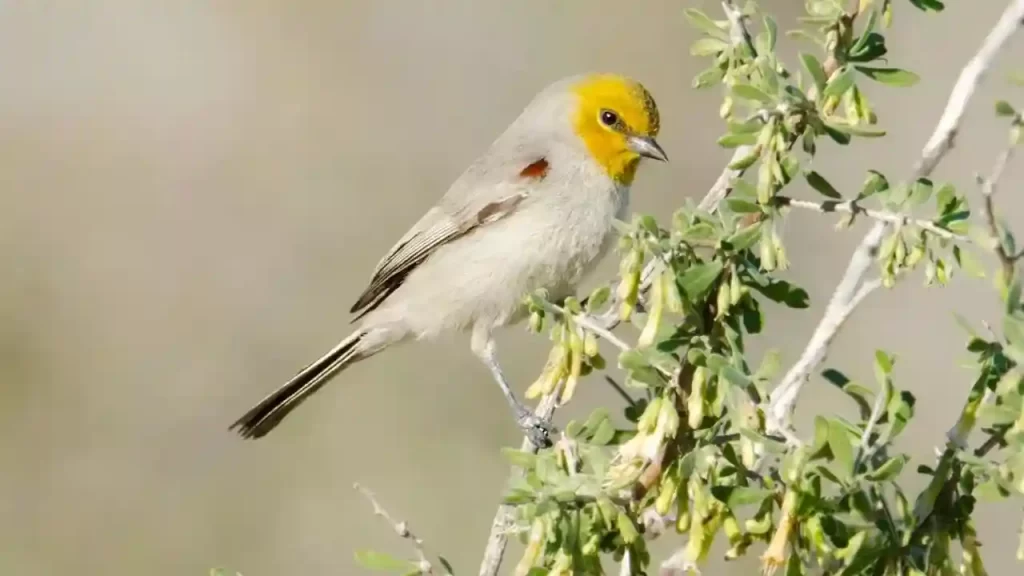
Verdin is a very small bird. Average 4.5 inch (11 cm) in length, weight 7 grams.
Scientific Classification of the Verdin
- Scientific Name: Auriparus Flaviceps
- Common Name: Verdin
- Kingdom: Animalia
- Phylum: Chordata
- Class: Aves
- Order: Passeriformes
- Family: Remizidae
- Genus: Auriparus
- Species: Auriparus Flaviceps
Verdin is a small, colourful species of small birds in the family Paridae. These colourful birds are small, average 4.5 inch (11 cm) in length. The species name flaviceps is Latin for “with yellow tail”.
The name derives from the yellow to light orange colour of the tail. The word “verdins” comes from the Spanish word “verdín”.
This is a synonym for “verdini” or “verdín”, which in the Spanish language refers to the colour of a small greenish fruit.
Distribution:
Verdins are a species of medium-sized passerines found in South and Central America, in the United States, Mexico and Caribbean.
The verdins are not found in the Northern or North-East parts of the world. The verdin is a native of the American continent.
It was first described by the German ornithologist, John Latham in his Ornithological Dictionary published in 1802.
Biology:
Verdin is mainly a bird of the forests, as it inhabits mature trees and bushes. It is widely distributed and can be found in both the dry and the wet seasons. Its feeding habits depend upon the season.
Breeding:
During the breeding season, the verdins have a distinctive song. It is similar to the sounds of the tree-creepers, the flutelike flute and the nightingale.
During the breeding season, the female produces the song, which is mainly heard at night. The song of the verdin is an important part of its breeding season.
The song can be likened to a tinkling musical sound with a metallic sound that is a bit like a “zipping”.
The verdins are non-migratory birds. They are generally resident in the same area for the life of the bird. However, it is possible for a verdin to travel considerable distances to various feeding sites.
Diet:
A typical verdin diet is composed of insects, fruits, vegetables and some seeds. The females feed their offspring with nectar and insects. The male bird helps feed the young birds.
A study was conducted on the verdins in the American states of Florida and Oklahoma. It revealed that the verdin feeds on aphids, caterpillars, bugs and even ants.
They are also able to eat soft fruits, especially figs. They are fond of fruits that contain seeds, such as grapes, apples, mangoes, peaches, plums, melons, oranges, raisins and pineapples.
They also like the sweet taste of fruits with a little sour taste.
8 out of 10
Brown Gerygone (Gerygone Mouki)
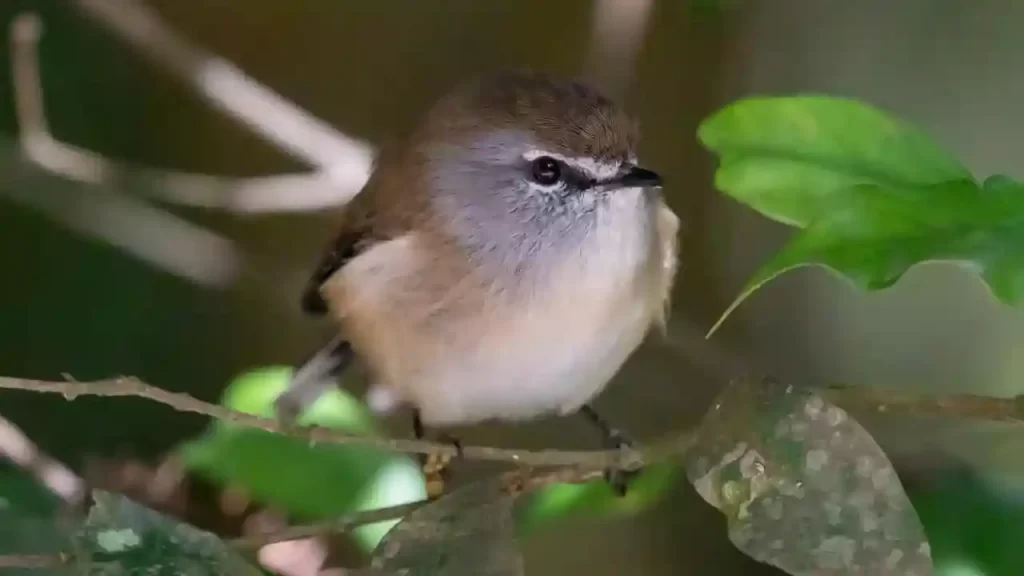
Brown Gerygone is average 4.4 inch (10 cm) in length, weight 6 grams.
Scientific Classification of the Brown Gerygone
- Scientific Name: Gerygone Mouki
- Common Name: Brown Gerygone
- Kingdom: Animalia
- Phylum: Chordata
- Class: Aves
- Order: Passeriformes
- Family: Acanthizidae
- Genus: Gerygone
- Species: Gerygone Mouki
Brown Gerygone is a very small bird. Average 4.4 inch (10 cm) in length, 6 grams. Brown gerygone is a species of Gerygone and is endemic to India.
The species was discovered and first described by Bower in 1872. The species is restricted to a small area-Darjeeling and Sikkim where only one population is known.
This species is found to occur in the hilly regions of Sikkim and East-Himalayas. It also occurs in some areas of eastern Himachal Pradesh.
Brown gerygone is easily distinguished from other similar looking species of Gerygone. The distinguishing features are- the size of the species (body length is 30-40 mm).
The very thick scutellum, scutal bristles are longer than wing, body of female is slightly shorter than that of male.
Description:
The size of the body is 30-40 mm. The upper-parts are brown and rusty-red. The rump is black. Under-parts are rusty-red with a slightly tawny tinge.
The forehead, crown, throat, breast, back, and tail are black. The wing-coverts and tail are grey. The legs are black. The iris is dark.
There is a patch of golden-yellow (golden-orange) on the upper-tail coverts and lower-breast. The bill is slender and horn coloured. The eye is greyish. It has a thick and dark scutellum.
The upper-tail coverts are black with a small brownish-yellow patch in the centre. There is a small notch at the base of the bill. The culmen is black and slender.
The tarsus is slightly thickened. It has a dark tail with oval-shaped (not tapered) dark-tipped feathers (plumes). The tail feathers are longer than the wing-coverts.
It has three pairs of scutal bristles and eight pairs of wing-coverts. It has a dark stripe on the throat that is less obvious in females. The tail plumage is changed after the moult.
Habitat:
The species occurs in montane and sub-montane temperate forests. The habitat of this species has been changed in various parts of the Himalayan foothills, mainly in Darjeeling.
The species is found in the montane forests of North-East to Central-Himalayas. This species is found to occur in hilly and mountainous regions of Sikkim and East-Himalayas.
Behaviour:
In the past, the species was hunted and taken for food. It was described by Burrow as a rare species, rare enough to be sought after for food.
But during the last century, the species have lost much of their natural habitats. The species are now mainly found in the hilly regions of Darjeeling.
However, the species has now been classified as Endangered on account of the habitats lost. The species is found to be more or less migratory in some regions.
It is thought that the species is more likely to be found in the lower and mid altitudes of the mountain regions of Sikkim, Sikkim, East-Himalayas, Nepal, Bhutan and China.
In some of the localities of the Eastern Himalayan Region, it has been recorded to occur in the forests with tall trees and shrubs.
In other regions, the species is found in the montane forest where the vegetation is mostly made up of the liane or the shrubs.
This species also occurs in secondary forests where it is more tolerant of secondary growth conditions.
Status:
There is a single population. The species is known to occur in two areas of the hilly regions of northern India.
The species is known from only two areas- Darjeeling and Sikkim where there is a population of only about 35 to 40 individuals.
In Darjeeling, the species was reported from two different localities- Singlis and Siliguri. It is rare in Siliguri and occurs only as a single male.
In Singlis, the species was found in a relatively small area in Darjeeling along the river banks of the Teesta River. Further, the species is known to occur in some areas of eastern Himachal Pradesh.
In the eastern part of Himachal Pradesh, the species is known to occur in the forests with tall trees and shrubs.
In some of the localities of the eastern Himachal Pradesh, the species was recorded in secondary forests where it is more tolerant of secondary growth conditions.
The areas with the highest density of this species are in the Teesta, Koyang, Sub-Himadri-Himalaya and Rongbori (Kali-Bhimtal) regions.
7 out of 10
Spotted Pardalote (Pardalotus Punctatus)
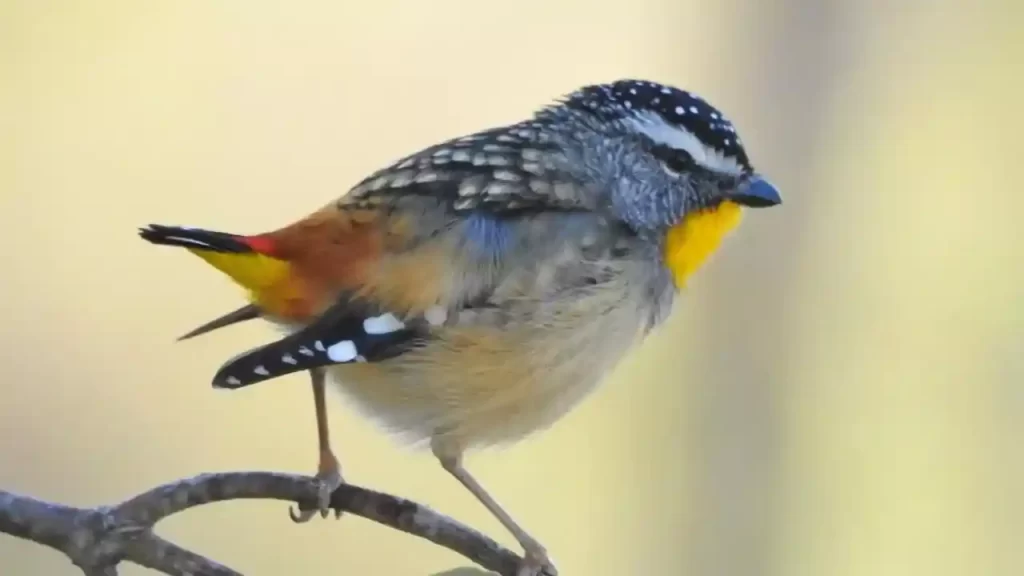
Spotted Pardalote is one of the smallest of all Australian birds, Adults generally grow to about 8 to 10 cm (3.1 to 3.9 inch) in length, 6 grams.
Scientific Classification of the Spotted Pardalote
- Scientific Name: Pardalotus Punctatus
- Common Name: Spotted Pardalote
- Kingdom: Animalia
- Phylum: Chordata
- Class: Aves
- Order: Passeriformes
- Family: Pardalotidae
- Genus: Pardalotus
- Species: Pardalotus Punctatus
Spotted Pardalote is a member of the Pardalotidae family, found throughout Australia. This parrot is often confused with its very similar cousins the Western and Eastern Pardalotes.
And is known for its bright plumage, which is also highly variable in colour and pattern. There are no records of hybridization between Western and Eastern Pardalotes.
But the Spotted Pardalote is not considered as endangered as the Western Pardalote. There are eight subspecies, with the Spotted Pardalote being more popular in areas with greater rainfall.
The plumage also differs between the subspecies, but is generally darker in the warmer areas of Australia. Adults generally grow to about 8 to 10 centimetres (3.1 to 3.9 in) in length, 6 grams.
As adults, they have a yellowish-orange body, and a white throat, which can sometimes be streaked or barred. The head and tail are dull, and they have short, blunt wings.
Their legs and feet are brown, with a greyish-blue tinge. They eat seeds, fruit, and nectar, and can be found in dry eucalypt forests, savannas, or dry bushland.
Although Pardalotes are considered solitary animals, they can be found in groups during breeding season.
Habitat and Distribution:
Spotted Pardalote is most commonly found in dry woodland areas, such as dry eucalyptus forests, dry grassland, or dry bushland.
They are often found in wooded savannas, where there is sufficient access to water. They are generally found throughout Australia.
Though some areas are more preferable to the Spotted Pardalote than others. The subspecies is considered as vulnerable throughout the mainland of Australia.
But there is no evidence of the Spotted Pardalote being affected by habitat loss or degradation.
Behaviour:
While Spotted Pardalotes are commonly considered as social birds, there is a high level of individual variation.
They are very friendly to humans, and can be found in pairs, small groups, or even single birds. They tend to be very tame, and may perch on an object while they await their next meal.
If they are approached, they will generally approach humans, and will even accept food from their hands. Generally, the Spotted Pardalote is considered as a solitary bird.
They rarely pair, and will sometimes be found in groups, but most of their activity is done alone. They are territorial, and are most active in the early morning or late afternoon.
This is because they generally sleep during the daylight hours, and spend their time wandering throughout their territory. The Spotted Pardalote will roost in trees at night, or on bushes or trees.
They will generally sleep in the uppermost areas of a tree, or in large shrubs. As with many parrots, they make use of natural cover.
Because the Spotted Pardalote is one of the largest species of parrot, it can be intimidating to small humans.
They are, however, fairly harmless, and not likely to bite unless they are angry or confused. They also have a high level of dexterity, as they can sometimes pick fruit off trees by themselves.
Diet:
Spotted Pardalote is an omnivorous animal that is primarily a seed eater. They will also eat fruits and nectar.
They have been observed to feed on figs, melons, kiwi, eucalyptus berries, cashews, and wild berries. They will also eat insects, though generally not in large numbers.
They are one of the few seed eaters to eat figs, and the fig consumption can be very high at certain times of the year.
The Spotted Pardalote will feed primarily in the early morning and late afternoon, as they sleep during the day.
They can be found in the higher elevations of trees in dry eucalyptus forests or grasslands. Due to their high levels of mobility, they can also be found in dry bushland and grasslands.
Their diet is very varied, and can be adjusted based on the time of year. In the warmer areas of Australia, they feed primarily on figs.
In the winter or cold season, they will consume more insects, and may even abandon the figs, which are not beneficial to them.
6 out of 10
Common Firecrest (Regulus Ignicapilla)
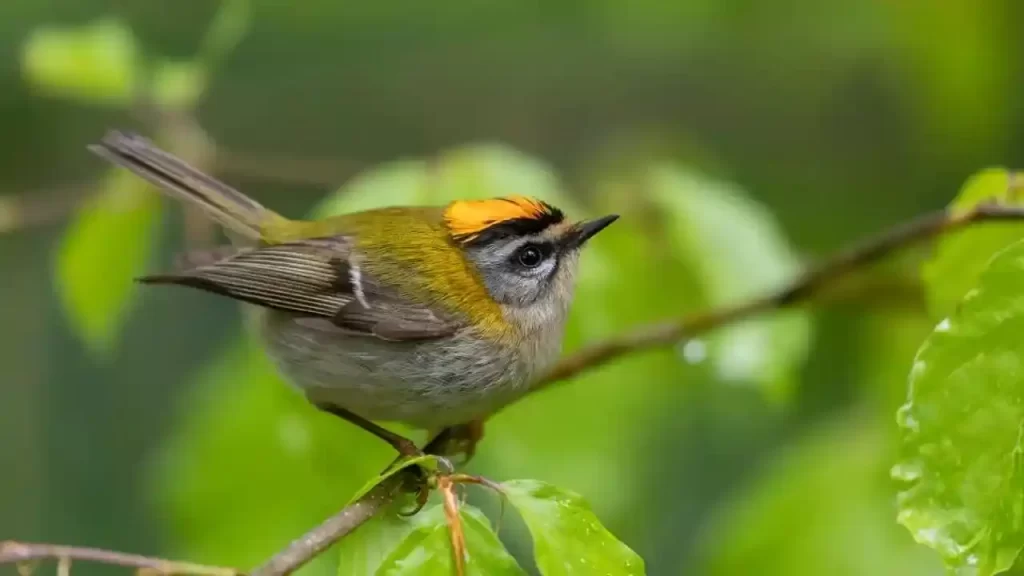
Common Firecrest is a small plump bird, average 9 cm (3.5 in) in length with a wingspan of 13 to 16 cm (5.1 to 6.3 inch), and weighs 4 to 7 grams.
Scientific Classification of the Common Firecrest
- Scientific Name: Regulus Ignicapilla
- Common Name: Common Firecrest
- Kingdom: Animalia
- Phylum: Chordata
- Class: Aves
- Order: Passeriformes
- Family: Regulidae
- Genus: Regulus
- Species: Regulus Ignicapilla
Common Firecrest is a small and plump subspecies of the widespread and common Firecrest species, and is found in most areas of the world where there are trees and woodlands.
It is a small bird with an olive-green back, darker than that of the Greater, and bright yellow underparts. There is a white shoulder line.
A fairly distinctive feature of the male is its bright red upper tail coverts. The Common Firecrest is a common bird in most parts of the world.
And is a common species throughout North America and Europe. It is fairly common in some places in Africa. It is not a rare bird, and probably very widespread.
It has recently been classed as being an example of the subgenus Regulus as a full species, Regulus ignicapillus, which is supported by the subfossil evidence and by genetic research.
However, it is also recognised as an example of the subgenus Aethopyga. In the past, some authorities have used the term “Fork-tailed Firecrest”.
To describe the Western subspecies of this bird, which has red, not black, upper tail coverts. In recent years.
However, the generic name Regulus has been changed, so that all the members of that genus are called Regulus, while the subgenus is now called Aethopyga.
Size:
Common Firecrest is slightly smaller than the other members of its genus, with a size range average 9 cm (3.5 in) in length with a wingspan of 13 to 16 cm (5.1 to 6.3 inch).
And weighs 4 to 7 grams in males and females. This species occurs primarily in the lowlands, where it favours clearings, riparian areas and secondary forest.
During migration, it is often found in mixed flocks with Common and American Goldfinches, but not with Song Sparrows.
This is a common migrant across western North America. It is a summer visitor in the U.S., but spends the winter in Central America and south to northern Argentina.
Plumage:
Common Firecrest, as its name implies, shows little contrast between the upperparts and the underparts. The plumage is mottled grey on the back and buffy grey on the underparts.
The juvenile has a buffy-grey back and heavily spotted buffy-grey underparts. The spots are slightly larger than those of the adult.
Juvenile common firecrest also shows a conspicuous eye-ring, though it is sometimes less distinct than in adults.
Habitat:
A frequent and often abundant occupant of lowland woodlands, this firecrest has been found in a variety of habitats.
During migration, Common Firecrest is often found in mixed flocks with Common and American Goldfinches.
During the non-migratory season, Common Firecrest frequents riparian areas, wooded clearings, and overgrown field edges.
It is an excellent bird to watch in spring, as male Common Firecrests are very active looking for nest sites and mates.
Behaviour:
This medium-sized forest-dwelling passerine is a common and sociable bird. It frequently occurs in mixed-species flocks.
Males are territorial during the breeding season, when they may defend a nest site and attempt to defend a pair-bonded female.
As with other Regulus species, Common Firecrests are monogamous and nest-faithful.
While the pair spends more time building a nest than other birds, the pair will typically be seen foraging together for food.
They breed in May, or whenever enough food is available to support their brood. However, nesting does not begin in earnest until the previous winter.
The female lays two eggs, although she will repeat this clutch a year later if conditions allow.
Eggs hatch between March 15 and April 5. Young fledge between April 15 and May 5. A nest tree for Common Firecrests is usually located in a fork of the tree near the ground.
Breeding:
Sometimes, a pair will nest on a hanging branch. Typically, a Common Firecrest nest tree will have a large cavity where the male will build a scrape.
This scrape is used by the female to line the inside of the nest and provide a warm roost for herself and her mate.
The Common Firecrest will often visit a number of potential nest sites in the vicinity of the nest tree and, by observing feeding activity in the tree, will learn which ones are likely to be successful.
A pair of Common Firecrests will defend the nest site until one or both of the parents are dead.
However, other bird species may use a nest if no nesting material is available. In the non-breeding season.
Common Firecrests may be found together in mixed-species flocks and may be seen moving through wooded habitats. These flocks may travel up to 100 miles.
As with other members of its genus, Common Firecrest is an excellent flyer. It can cover considerable distances at fast speed.
Diet:
Common Firecrest is one of the most omnivorous passerines. It is an opportunistic feeder, though foraging often involves locating insects.
The female Common Firecrest will feed alone in the morning, and the male alone in the late morning and afternoon. Also you can read top 24 smartest pet birds in the world.
Young Common Firecrests and juveniles eat insects, including many types of ants. The young also eat arthropods, such as grasshoppers, crickets, spiders and caterpillars.
They often clean insects from tree trunks and branches. The female will eat nectar during the breeding season, and will also consume flower pollen.
Male Common Firecrests will frequently follow the female during the breeding season, searching for insects to feed on. When she is not doing nest building, she will forage alone.
5 out of 10
Ruby Crowned Kinglet (Corthylio Calendula)
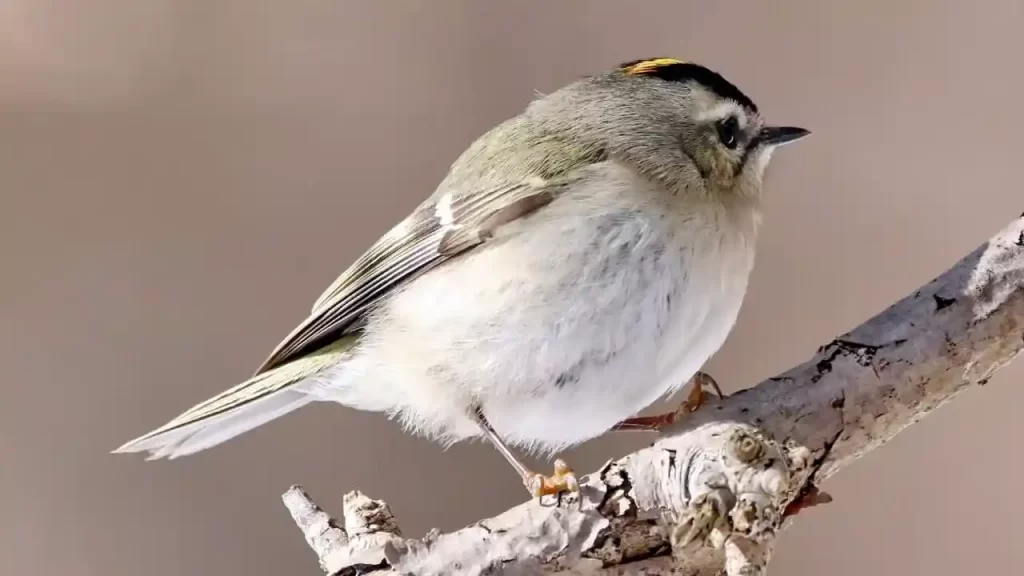
Ruby Crowned Kinglet is a very small bird, about 9 to 11 cm (3.5 to 4.3 inch) length, having a wingspan of 16 to 18 cm (6.3 to 7.1 inch), and weighing 5 to 10 grams.
Scientific classification of the Ruby Crowned Kinglet
- Scientific Name: Corthylio Calendula
- Common Name: Ruby Crowned Kinglet
- Kingdom: Animalia
- Phylum: Chordata
- Class: Aves
- Order: Passeriformes
- Family: Regulidae
- Genus: Corthylio
- Species: Corthylio Calendula
Ruby Crowned Kinglet is small, being 5 to 5.5 inches long. It weighs 8 to 10 grams. The males are slightly larger, having a length of 5.5 to 6 inches and a weight of 14 to 16 grams.
The females are only 4 inches long, weighing less than 9 grams. This species is one of the smallest members of the thrushes, and a most inconspicuous species.
It is a resident breeder in the mountains, from Canada east to New England, but is more likely to be found where it can find food and nesting sites.
It generally abounds on open mountain slopes and clearings, nesting in dense scrub growth and sometimes also in wooded areas.
The nest is a compact nest of plant stems, grass, etc., with a hanging entrance at the end of the tunnel. The normal clutch of 4 or 5 eggs is laid on the 15th or 20th day of May.
It is on the wing at the time of arrival of spring migrants, and departs for its summer breeding grounds early in June. In its northern migration it often passes through the District of Columbia.
The flight is rapid and direct. The male has a soft bill of a rich red or orange colour; the female is of a dusky white with pinkish lores and a bright pink throat.
The male Ruby Crowned Kinglet is seen occasionally in flocks of other birds, but its shy and retiring character causes it to be less common than other thrushes.
It has been found to occupy the same territory as a Blue Jay, though their range does not generally overlap.
For this reason it has been suggested that the two species do not interbreed, but this is not a sure thing. The female is never seen in large numbers.
A single hen is sometimes seen on the bare ground, feeding on the surface with the regularity of herring gulls and other shore birds.
Both sexes often feed together. Like most other thrushes, the feeding is usually conducted on the wing, with occasional plunging plunges.
Description:
Ruby Crowned Kinglet was first discovered in the mid 1800s on eastern Georgia’s Chattahoochee National Forest. A female kinglet, it is a close cousin of the Carolina and Carolina Mockingbird.
It is smaller, has a reddish-orange crown with blue wing linings, and prefers to eat small insects. In the fall, it migrates from its southern range to the northeastern United States and Canada.
It is known to nest in areas with both coniferous and broadleaf trees such as pine, oaks, and hickory.
Mating:
Mating usually occurs between May and August. Each Ruby Crowned Kinglet pair is very secretive, preferring to nest in a tree cavity that is in the centre of a bush or shrub.
They are faithful and will only mate with each other. They usually breed only one brood a year. A female lays one or two eggs in a shallow cup nest.
The female and male share the work of raising the nestlings, with the male doing the majority of the incubation and hatching the chicks.
He sings and flutters over his nest three to four times a day. Both parents will feed and protect the nestlings.
Parenting:
Nesting begins in mid to late May, with eggs usually laid in early June. The female lays two or three eggs. The male broods the nest until the chicks hatch.
The parents both feed the young while the eggs are still in the nest. Each day, the parents begin the courtship and mating behaviours.
Both sexes are good fliers and they feed and fly to the nest throughout the year.
Conservation:
Ruby Crowned Kinglet is a very rare breeding bird.
The Carolina population is listed as Critically Endangered and the Ruby has been added to the US Fish and Wildlife Threatened and Endangered species list.
Because of its small population and habitat loss, it has been the focus of several conservation programs.
However, it is very difficult to find and is listed as “Critically Imperilled” by the American Bird Conservancy.
Behaviour:
These little birds are great fliers. They fly to the nest, land on the branches, and flap back to the nest. As they eat, they are constantly moving and are very acrobatic.
If the branch they are on begins to move, they will continue to fly. They fly slowly and are hard to catch in a mist net.
They also are known to do somersaults while they are eating. These birds are very aggressive when threatened and will even bite.
Range:
Their breeding range is in the southeastern United States, including the Carolinas, Georgia, and Alabama. In the fall they migrate to the northern portions of the eastern United States and Canada.
Habitat:
Ruby Crowned Kinglet needs open woodlands with plenty of old tree hollows, but other habitats are included.
The most important requirement is trees, particularly tree hollows. They need thick, leafy shrubs as cover, and many areas in Georgia are not suitable because of lack of forest.
Diet:
Ruby Crowned Kinglet eats primarily insects. During the winter months, the male eats more than the female. As the Ruby Crowned Kinglet forages, it flies slowly and searches for insects.
It flies high, and occasionally, when disturbed, will dive to the ground. When it lands, it will fly to the nearest tree and continue its search.
Life Span:
These birds breed from May to August. The first chicks leave the nest at 17 days, and the last hatch from 28 to 31 days after the eggs are laid.
They live in or migrate to the northern parts of the eastern United States and Canada. The Ruby Crowned Kinglet lives two to four years in the wild.
Flight:
Ruby Crowned Kinglets can be recognized by their reddish-orange crowns and blue wing linings.
It is difficult to distinguish the male from the female because the male has a reddish-orange crown and pinkish-grey on the neck.
Also, the female has a brownish tail, whereas the male has a bright orange tail.
4 out of 10
Rufous Hummingbird (Selasphorus Rufus)
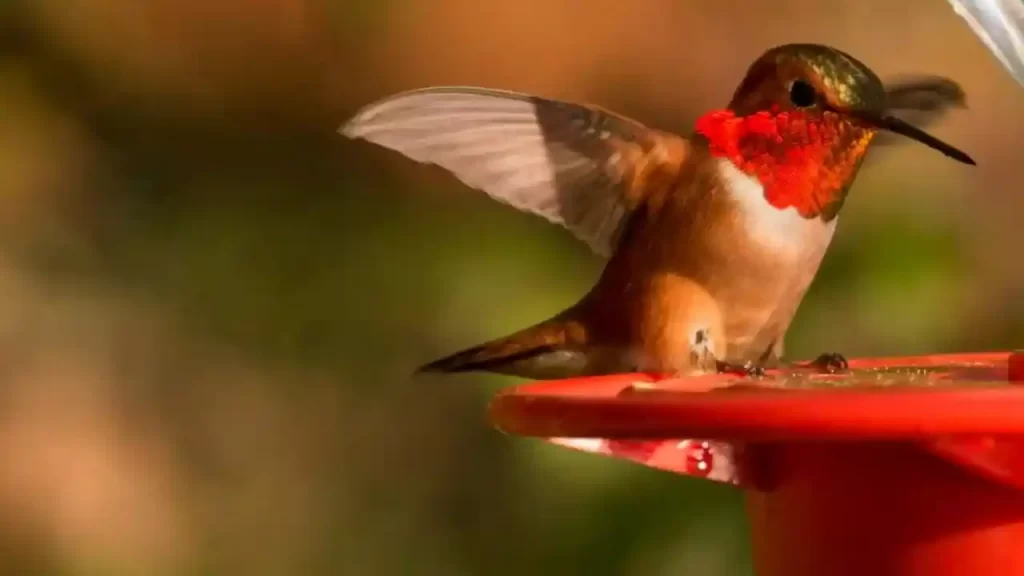
Rufous is a typical-sized hummingbird, being a very small bird. It weighs 2 to 5 grams, measures 7 to 9 cm (2.8 to 3.5 inch) length and wingspan 11 cm (4.3 inch).
Scientific Classification of the Rufous Hummingbird
- Scientific Name: Selasphorus Rufus
- Common Name: Rufous Hummingbird
- Kingdom: Animalia
- Phylum: Chordata
- Class: Aves
- Order: Apodiformes
- Family: Trochilidae
- Genus: Selasphorus
- Species: Selasphorus Rufus
Rufous Hummingbird’s distinctive long tail feathers are a diagnostic feature of all hummingbirds, as well as one of the most attractive parts of its body.
The rufous hummer has a black cap, with white rims around its eyes, a prominent white throat, a chestnut belly, and a long tail that is the most often used part to identify a hummingbird species.
Rufous Hummingbirds are found in nearly every part of North America, from southern parts of Mexico, as far south as Central America, all across the U.S.A.
And Canada, and right up into the Arctic regions. A good example of a rufous hummingbird is in the photo below.
This one was flying around the yard, and a big Rufous Hummingbird could be heard singing high overhead.
Size and Weight:
Rufous Hummingbird is a medium sized bird, averaging about it weighs 2 to 5 grams, measures 7 to 9 cm (2.8 to 3.5 inch) length and wingspan 11 cm (4.3 inch).
Habitat:
Rufous Hummingbirds are found in a variety of habitats in North America, from desert scrub, oak/pine forests, agricultural areas, backyards, roadsides, wooded canyons, and suburbs.
Diet:
Rufous Hummingbirds feed primarily on nectar from various flowers.
Movement:
This bird is a rapid flyer, but usually it stays still on a perch.
Breeding:
Rufous Hummingbirds have a lengthy courtship with their long feathers fluttering, and they also perform a courtship dance for each other.
They have one set of eggs in a shallow nest and incubate them for 8 to 10 days.
Identification:
Rufous Hummingbirds have characteristic long tail feathers which are the most distinguishing feature of the genus. Other birds like to mimic this long tail which leads to a lot of confusion.
When you do see a long tail on a hummingbird, try to imagine a bird with an even longer tail and see how it differs.
Birds with long tails are not the only hummingbirds with long tails, but they are the only ones that are found in North America. A rufous hummingbird feeds on the nectar from flowers.
Rufous hummingbirds tend to have a shorter tail than others in the genus. Rufous Hummingbirds have long feathers on their tails which distinguishes them from all other species.
Like other hummingbirds, the males and females perform a courtship dance.
3 out of 10
Weebill (Smicrornis Brevirostris)

Weebill size averages 8 to 9 cm (3.1 to 3.5 inch) length, and weighs 3 to 4 grams.
Scientific Classification of the Weebill
- Scientific Name: Smicrornis Brevirostris
- Common Name: Weebill
- Kingdom: Animalia
- Phylum: Chordata
- Class: Aves
- Order: Passeriformes
- Family: Acanthizidae
- Genus: Smicrornis
- Species: Smicrornis Brevirostris
Weebill are a relatively small, brownish-grey bird. They are very short-legged. The body is relatively stout and their wings are short.
Weebills have soft brown feathers, and a white belly that goes to a large orange bill. The females are a little bit larger and heavier than the males.
But both genders have similar-sized legs and similar overall body structure. Males are around 14 centimetres long and females are around 12 centimetres long.
The Weebill can be distinguished from other short-legged, brownish birds such as Ocellated Towhee because their beaks are much more than 20 millimetres long.
Food and Feeding Habits:
Weebill is a relatively small bird, but due to their need for a large amount of food, they have some of the largest beaks in the avian order. The Weebill feeds on seeds, fruits, buds, nectar, and insects.
They are very active and eat a variety of foods. Since they don’t have that much body mass, their energy needs are high.
In order to supplement their diets, Weebills dig for seeds and underground bulbs to eat.
Behaviour and Ecology:
It is not yet known exactly what Weebills are doing in order to be so territorial. However, Weebills are territorial, very active, and tend to be more active during the day.
They are also highly social animals and it is believed that territorial behaviour is more common among closely related species. The Weebill often displays to another species to warn them of danger.
The warnings are mostly used when an intruder or a predator threatens the Weebill. The warnings can also be used to warn others of potential mating activity.
As a social species, they are very sociable and do most of their activities in a group. They like to live near others and tend to associate with others that are the same age.
Mating and Courtship:
After a breeding season, the Weebill starts to pair off for their mating season. Courtship can be a long process for the Weebill as it can take up to four days to complete.
During courtship, a male Weebill will use a variety of sounds in order to attract a female. He will begin to whistle and make a series of calls.
He will do this at a certain time and then wait to see if she will come. Then he will continue making the whistling sounds to attract her.
If she is receptive, he will begin displaying to her, making a characteristic call. They also use their beaks and feathers as displays, to see if the female is receptive.
The male will display in a vertical position. He will continue to make a series of whistling sounds and also display and if she responds.
He will lower himself in a horizontal position and eventually, she will pair with him.
Breeding and Nesting:
Weebills breed in the spring and the first thing a female does is find a nest. It is not known exactly where a Weebill nests.
But they are known to nest on the ground, in open grasslands or areas of shrubs. They also tend to build nests in groups of 7 to 11.
Weebills build their nests in a way that there are two openings to the nest. These openings allow the mother Weebill to leave the nest and bring food to the chicks.
The nest itself is built of large sticks and leaves and sometimes branches, it is only around four inches in height. The nest is lined with large leaves.
They also collect many small sticks, grasses, and dead leaves and make a type of nest that is not used by other birds. They then add the sticks to the nest.
While building the nest, the female Weebill will make a loud sound called a cluck. The cluck is very loud and very similar to the sounds that domestic turkeys make.
The cluck is produced by making the tongue stick out, with an opening on one side that has a loud squeak.
These calls are used to communicate with other Weebills and for communication with other species. They also use their beaks to push the sticks into the nest.
The mother Weebill then places the sticks in the nest. She will also gather around the nest and fan it while making the cluck. The Weebill eggs hatch in about 25 to 40 days.
The Weebill is a colonial bird, which means that the young chicks hatch one right after the other. The female Weebill will lay the eggs in her nest, then leave.
When the nestlings hatch, she will return to feed them. Sometimes, an older sibling will steal the food.
However, this doesn’t seem to be a problem because after a few days, the nestlings will get used to their siblings stealing their food. As the Weebills grow, the mother feeds them.
After the chicks are around three to four weeks old, the mother brings food to the nest on her head. Then, after a few days of leaving the food, she returns and brings food back on her head.
By this time, they are well-grown and ready to move out of the nest. By this point, the Weebills can also fly and hunt for food on their own.
Feeding and Migration:
During the spring, Weebills begin to feed soon after their birth. This is the period when their feeding habits are really different from those of the rest of the year.
They use their large beaks to dig for and eat seeds. As they age, they become less interested in eating seeds and more interested in eating insects.
While they are still in the nest, they feed off of their mother’s milk. After a few days of feeding, they will start moving away from their nest. During their early life, they will feed on their parents’ food.
When they are old enough, they will feed off their mother’s excrement. Once they leave the nest, they won’t need to feed off their parents, but they are still able to get food from others.
They will eat fruits and nuts, and sometimes, bugs. During the spring, their migration is very slow.
They feed and spend most of their time in areas near water. They also feed on the shores of lakes, and beaches.
Status, Distribution, and Habitat:
Because of their territorial nature and tendency to live close to others, the Weebills are endangered. They tend to live in dense areas that have food sources, and water.
When a habitat is destroyed, the Weebills tend to migrate away from the area. The Weebills are now found in some parts of the United States, Mexico, and Canada.
The Weebills can be found in the southeastern part of the United States.
Conservation:
Weebills are highly territorial and can be easily frightened by some other species. Unfortunately, their territorial nature is leading to habitat loss and even complete destruction.
They also do not have much in the way of defensive skills. These two facts mean that they are at risk of becoming endangered.
Since they live in large colonies, the Weebills have little ability to protect themselves from predators. Their lack of defensive skills also make them vulnerable to predators that want to eat the Weebills.
Humans have an effect on the Weebills because they take away their food sources and destroy their habitat.
2 out of 10
Costa’s Hummingbird (Calypte Costae)

Costa’s Hummingbird is very small, a mature adult growing to only 3 to 3.5 inch (7.6 to 8.9 cm) in length, a wingspan of 11 cm, and an average weight of 3.05 grams for males and 3.22 grams for females.
Scientific Classification of the Costa’s Hummingbird
- Scientific Name: Calypte Costae
- Common Name: Costa’s Hummingbird
- Kingdom: Animalia
- Phylum: Chordata
- Class: Aves
- Order: Apodiformes
- Family: Trochilidae
- Genus: Calypte
- Species: Calypte Costae
Costa’s Hummingbird is the smallest bird in North America that migrates outside of the tropics.
Hummingbirds were the first of the North American birds that are native to North America to be recorded for the first time in Europe, since the late 16th century.
Biology:
Costa’s Hummingbird is a tropical hummingbird with a maximum length of 3 to 3.5 inch (7.6 to 8.9 cm).
Adult males and females differ only in the females having a brownish-white throat, while the male’s throat is entirely red. They have a long, curved, white beak. Their legs are long and black.
They are covered with small, scale-like feathers that are orange-red at the base and change to orange on the top and around the eyes.
The males have no black tips to their tail feathers. They have an average lifespan of 5-8 years.
Habitat:
Costa’s Hummingbird can be found in dry open areas throughout the U.S., as well as in northern parts of Mexico.
They prefer open, sunlit areas with large numbers of their food plants, especially species from the genus Heliconia.
These include the Costa’s Heliconia (H. caesia), the white-tipped Heliconia (H. pachysiphon), the trumpet Heliconia (H. longicornis), and the yellow Heliconia (H. pinnata).
Breeding and Nesting:
These birds spend long hours incubating their eggs. Costa’s Hummingbirds build a large, cup-shaped nest attached to Heliconia plants.
Inside the nests are three white eggs and often another egg (if a second clutch is laid). The eggs have a brown or bluish tinge and are unmarked.
Distribution:
Costa’s Hummingbird’s breeding range is along the tropical Pacific Coast of Central America and the southern Caribbean.
Their breeding range then extends north into Mexico’s Yucatan Peninsula, where they winter.
In the winter, the bird flies north to southern Canada, eastern Canada, and the United States, and west as far as Arizona, California, and the Pacific Northwest.
Food:
Costa’s Hummingbirds feed mainly on nectar and often supplement it with small insects.
Many nectar plants in Costa Rica are endemic and some of them are only found in this area. They also feed on insects and spiders.
Behaviour and Life History:
After leaving their nests, hummingbirds eat small amounts of nectar. They are very fast and agile fliers.
They also drink a great deal of water throughout the day and can drink up to 2.5 cups of water per hour.
1 out of 10
Bee Hummingbird (Mellisuga Helenae)

Bee Hummingbird is the smallest living bird. Females weigh 2.5 grams, and are 6.1 cm (2.4 inch) long, and are slightly larger than males, which have an average weight of 1.9 grams, and length of 5.5 cm (2.2 inch).
Scientific Classification of the Bee Hummingbird
- Scientific Name: Mellisuga Helenae
- Common Name: Bee Hummingbird
- Kingdom: Animalia
- Phylum: Chordata
- Class: Aves
- Order: Apodiformes
- Family: Trochilidae
- Genus: Mellisuga
- Species: Mellisuga Helenae
Bee Hummingbird is known for its colourful plumage, and for its high-frequency vocalisations. When these qualities are combined, a bee hummingbird is a delight to watch.
Bee hummingbirds are relatively large hummingbirds, from females weighing 2.5 grams, and are 6.1 cm (2.4 inch) long, and are slightly larger than males, which have an average weight of 1.9 grams.
And length of 5.5 cm (2.2 inch). Bee hummingbirds are fairly long-legged, with long pointed wings, strong feet, and large round eyes with forward-facing vision.
Their tails are very small and their feathers, particularly the males, are bright orange, buff, and black. Males are usually a brighter orange, especially on the tail and rump, than females.
The males’ feathers have a black bar in front and behind the middle. Females have greyish-white mottled feathers.
But otherwise similar to male, save for their brownish-orange bills and larger rounded wings, which show more yellow.
Females nest in small shrubs, tree cavities, and in areas where a tree or nest sticks out from the surrounding foliage.
Allowing the females to hover and make a variety of vocalisations at perching and while moving between nesting sites.
Bee hummingbirds are often seen on power lines and near orchards, where they feed on nectar, sugar water, and insects, as well as the pollen found in the flowers of some trees.
Habitat:
Most bee hummingbirds nest and spend the majority of their lives in the southeastern part of the United States, and in southern Mexico.
Bee hummingbirds are often seen foraging for insects on power lines and near orchards.
While they may also feed on the nectar and pollen of a wide variety of flowering trees and shrubs, they do seem to prefer the pollen found in the flowers of several trees.
Including but not limited to sassafras, holly, hackberry, and maple. Many bee hummingbirds forage at sunset and early morning, but most forage in the morning during the summer.
The foraging time varies throughout the year, from October through April, but is most active from March through May, depending on the year.
In the spring and summer, bee hummingbirds also can be found feeding at a variety of water sources.
Breeding:
Bee Hummingbirds lay a single egg (usually white or light blue in colour) into a cavity, either in a tree or shrub, or in a nest box.
During the nesting season, the female bee hummingbird may use a variety of nesting sites, often a cavity in the base of a flowering tree.
But will also use man-made structures, including bird boxes, artificial nest boxes, and even plastic garbage cans. She will usually use trees, shrubs, and the base of the trees.
The nest is about the size of a robin’s egg. The female bee hummingbird will make a series of soft, buzzing calls, usually at regular intervals, at a level that only she can hear.
She will also make these calls in a variety of colours and tones. Sometimes the calls will contain information about the nest’s position in the tree. Often, these calls are of varying frequency.
She will also make a series of “chatter” calls to get the attention of a potential mate. There are very few species of bee hummingbird, and there is little variation in the behaviour or location of the nest.
It is thought that this is because the majority of the breeding population is concentrated in a very limited geographic region.
Conservation:
The IUCN lists the bee hummingbird as “Least Concern” because of its wide distribution and a large population.
Behaviour:
Bee Hummingbirds are not territorial. If two females are in the same tree, they may both choose to occupy it, and sometimes, a male will take over the tree if there is a vacant nest.
The only other bird that is known to nest in bee hummingbird trees are northern mockingbirds (Mimus polyglottos).
Diet:
Although a bee hummingbird is usually called a hummingbird, it is actually a fairly large bird.
Bee hummingbirds are often known as hummingbirds because of their small size, especially the males, which are smaller than the females.
The bee hummingbird is also called a vireo because of their loud high-pitched calls. The bee hummingbird’s diet consists of a large amount of insects, especially for the size of the bird.
But also includes pollen, small amounts of fruit and honey, nectar, and sugar water. They are attracted to and feed on flowers that provide pollen and nectar.
And they will take insects of all types and sizes, even if they do not need the energy. The bees will take honey and sugary drinks from visitors to their tree.
The bee hummingbird does not seem to be very selective with its forage.
However, because they are territorial, they will usually only forage in areas that are not used by other birds, including nectar and pollen from their food sources.
The bee hummingbird uses a variety of strategies to capture insects. It will fly up to the flower, perch on the petals, and grasp the insects using their sharp, hooked bill.
They also open the bill and swallow them whole. It is thought that the bee hummingbird’s bill is extremely flexible, being able to move in a variety of ways.
In addition to a sharp, hooked bill, the bee hummingbird’s foot is very large and strong and they can grip twigs with great strength and stability.
The bee hummingbird also has a very powerful yet delicate tail, which they use to balance themselves on the perches they use for foraging.
The bee hummingbird will also eat small amounts of fruit and honey.
I hope you enjoyed our article about the top 10 smallest birds in the world. If yes, then do share these articles with your loved ones, family, and friends.
Thank you for Reading!

